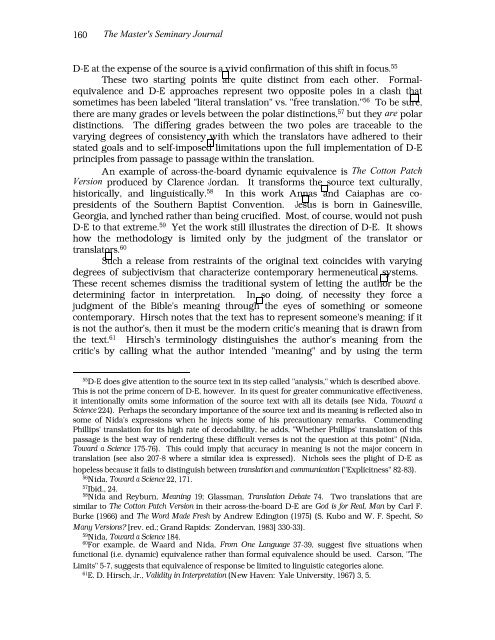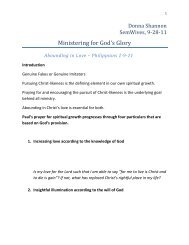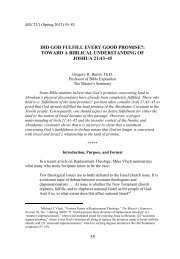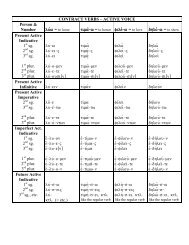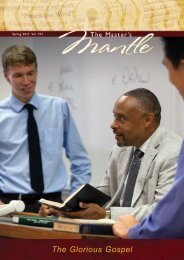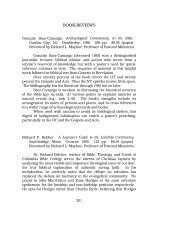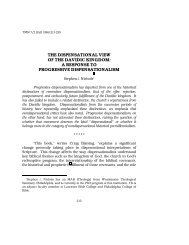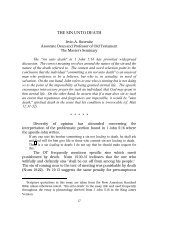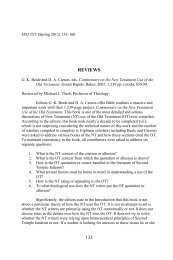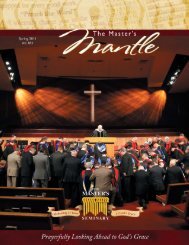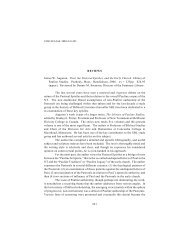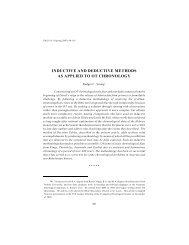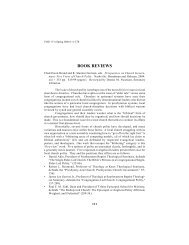dynamic equivalence: a method of translation or a system
dynamic equivalence: a method of translation or a system
dynamic equivalence: a method of translation or a system
- No tags were found...
You also want an ePaper? Increase the reach of your titles
YUMPU automatically turns print PDFs into web optimized ePapers that Google loves.
160 The Master's Seminary JournalD-E at the expense <strong>of</strong> the source is a vivid confirmation <strong>of</strong> this shift in focus. 55These two starting points are quite distinct from each other. F<strong>or</strong>mal<strong>equivalence</strong>and D-E approaches represent two opposite poles in a clash thatsometimes has been labeled "literal <strong>translation</strong>" vs. "free <strong>translation</strong>." 56 To be sure,there are many grades <strong>or</strong> levels between the polar distinctions, 57 but they are polardistinctions. The differing grades between the two poles are traceable to thevarying degrees <strong>of</strong> consistency with which the translat<strong>or</strong>s have adhered to theirstated goals and to self-imposed limitations upon the full implementation <strong>of</strong> D-Eprinciples from passage to passage within the <strong>translation</strong>.An example <strong>of</strong> across-the-board <strong>dynamic</strong> <strong>equivalence</strong> is The Cotton PatchVersion produced by Clarence J<strong>or</strong>dan. It transf<strong>or</strong>ms the source text culturally,hist<strong>or</strong>ically, and linguistically. 58 In this w<strong>or</strong>k Annas and Caiaphas are copresidents<strong>of</strong> the Southern Baptist Convention. Jesus is b<strong>or</strong>n in Gainesville,Ge<strong>or</strong>gia, and lynched rather than being crucified. Most, <strong>of</strong> course, would not pushD-E to that extreme. 59 Yet the w<strong>or</strong>k still illustrates the direction <strong>of</strong> D-E. It showshow the <strong>method</strong>ology is limited only by the judgment <strong>of</strong> the translat<strong>or</strong> <strong>or</strong>translat<strong>or</strong>s. 60Such a release from restraints <strong>of</strong> the <strong>or</strong>iginal text coincides with varyingdegrees <strong>of</strong> subjectivism that characterize contemp<strong>or</strong>ary hermeneutical <strong>system</strong>s.These recent schemes dismiss the traditional <strong>system</strong> <strong>of</strong> letting the auth<strong>or</strong> be thedetermining fact<strong>or</strong> in interpretation. In so doing, <strong>of</strong> necessity they f<strong>or</strong>ce ajudgment <strong>of</strong> the Bible's meaning through the eyes <strong>of</strong> something <strong>or</strong> someonecontemp<strong>or</strong>ary. Hirsch notes that the text has to represent someone's meaning; if itis not the auth<strong>or</strong>'s, then it must be the modern critic's meaning that is drawn fromthe text. 61 Hirsch's terminology distinguishes the auth<strong>or</strong>'s meaning from thecritic's by calling what the auth<strong>or</strong> intended "meaning" and by using the term55D-E does give attention to the source text in its step called "analysis," which is described above.This is not the prime concern <strong>of</strong> D-E, however. In its quest f<strong>or</strong> greater communicative effectiveness,it intentionally omits some inf<strong>or</strong>mation <strong>of</strong> the source text with all its details (see Nida, Toward aScience 224). Perhaps the secondary imp<strong>or</strong>tance <strong>of</strong> the source text and its meaning is reflected also insome <strong>of</strong> Nida's expressions when he injects some <strong>of</strong> his precautionary remarks. CommendingPhillips' <strong>translation</strong> f<strong>or</strong> its high rate <strong>of</strong> decodability, he adds, "Whether Phillips' <strong>translation</strong> <strong>of</strong> thispassage is the best way <strong>of</strong> rendering these difficult verses is not the question at this point" (Nida,Toward a Science 175-76). This could imply that accuracy in meaning is not the maj<strong>or</strong> concern in<strong>translation</strong> (see also 207-8 where a similar idea is expressed). Nichols sees the plight <strong>of</strong> D-E ashopeless because it fails to distinguish between <strong>translation</strong> and communication ("Explicitness" 82-83).56Nida, Toward a Science 22, 171.57Ibid., 24.58Nida and Reyburn, Meaning 19; Glassman, Translation Debate 74. Two <strong>translation</strong>s that aresimilar to The Cotton Patch Version in their across-the-board D-E are God is f<strong>or</strong> Real, Man by Carl F.Burke (1966) and The W<strong>or</strong>d Made Fresh by Andrew Edington (1975) (S. Kubo and W. F. Specht, SoMany Versions? [rev. ed.; Grand Rapids: Zondervan, 1983] 330-33).59Nida, Toward a Science 184.60F<strong>or</strong> example, de Waard and Nida, From One Language 37-39, suggest five situations whenfunctional (i.e. <strong>dynamic</strong>) <strong>equivalence</strong> rather than f<strong>or</strong>mal <strong>equivalence</strong> should be used. Carson, "TheLimits" 5-7, suggests that <strong>equivalence</strong> <strong>of</strong> response be limited to linguistic categ<strong>or</strong>ies alone.61E. D. Hirsch, Jr., Validity in Interpretation (New Haven: Yale University, 1967) 3, 5.


